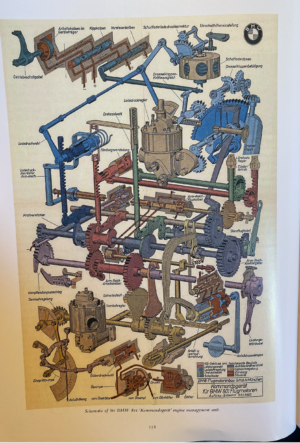The author of this book kindly referenced me in this important work, so I feel happily obliged to give it a review. Tim Wilson is the professor at CSTPV in St Andrews University, an organisation I had some interaction with a couple of decades ago, and it remains a leading academic organisation looking at terrorism. The book examines how terrorism or political violence has become commonplace in the modern world and I think is an important contribution. It helps that it is very readable and of course I’m flattered to be referenced so I hope this doesn’t come across as too biased a review. I think the book is a well structured analysis, providing the context for terrorism but also examining what makes it so prevalent in the modern age. My review below is less well structured – I’m going to highlight certain concepts that the author brings out which intrigue me.

Of course I should make clear that I don’t regard myself as a historian at all – I’m simply interested really in the technical evolution of some of the things terrorists use, and that gives me a slanted perception, but also perhaps a valid one.
- Early on in the book, the “disarming of society” as it occurred some centuries ago in Europe is discussed. I think this is interesting and highlights some tricky issues, relating to firearms in particular and the associated culture of these weapons. In Europe the advent of firearms in the 16th, 17th and 18th century as the primary weapon of violence really only affected armies. Other than a small number of hunting firearms, the most powerful weapon was in the hands of the military. Society was not given access to firearms in any sense that enabled them politically. This began , I think, early in the 1500’s with the development off the wheellock which I have written about recently. Early on in that century wheellocks were banned from use in a number of countries, and a real threat was seen from the fact that they could be concealed. Emperor Maximilian I banned them from use in Austria and then throughout the Holy Roman Empire. As the author points out, there was also a cultural move against weapons in general, with their use either not favoured from custom or banned in law. It fascinates me that now in the 20th century many parts of the world deadly weapons are, in some places, now de rigueur in some societies. And there’s the whole American firearms can of worms that I’m not going to dive into here – other than point out its curious anomaly.
- The 18th century brought a political motivation to upend order from populations, or parts of populations, rather than being solely driven perhaps the cruder aspirations of powerful individuals as was seen before. The French and the American revolutions seem to be the genesis, and indeed from my own narrow perspective the use of explosive weapons was not unknown even at this time. These revolutionary fervours seem to have been re-ignited in the 1840s albeit with limited success, and they gained pace throughout the latter part of the 19th century, when various revolutionary themes, such as social revolution, anarchy, Irish nationalism, and other febrile politics all provided an environment for political violence to proliferate. Of course at the same time, significant scientific strides were also occurring in regards to the development of explosives. The use of explosive weapons for political violence was not new in the late 19th century but certainly became much more commonplace. In my view, a number of things converged to make this happen
- Revolutionary or political fervor
- Scientific advances making explosive devices more effective
- Knowledge of the science
- Availability of components (linked naturally to the preceding two factors)
- In terms of the scientific advances, the author refers to Walter Laqueur’s concept, first really put out in his 1977 book “Terrorism”, of what he calls the “minaturization” of explosive devices and to be honest I struggle to see this as a valid concept. What Laqueur sees as “miniaturisation” of IEDs , I think is better understood as the arrival on the scene of more “energy-dense” devices. Devices didn’t get smaller in the late 19th century as Laqueur suggests, they got more powerful. There were plenty of small devices seen in the decades and centuries before when gunpowder was the explosive charge. They got no smaller (in any particular way) in the anarchist, revolutionary and fenian bombs of the 1880s which contained dynamite or other high explosives. But the increased energy density made them more powerful, and therefore more effective. I certainly can see nothing “miniature” about these devices technically that makes them smaller than earlier low-explosive devices. Tim Wilson, to be fair, mostly identifies this flaw in Laqueur’s concept. I think there are quite a few examples of some pretty small devices prior to the 19th century – have a trawl through the 18th century devices in the link in the column to the right and you’ll see plenty of “small devices” that preceded the high explosive small devices of the late 19th century. To be blunt, Laqueur didn’t look hard enough when he said the first postal device was in 1895 – they had been around for decades or even centuries. Laqueur falls for the common failing of many in assuming that such things as explosive devices are always recent – something that is the purpose of this blog to counter. Laqueur is simply weak when it comes to technical matters. As an aside (and I apologise if this is turning into an anti- Laqueur diatribe), his assessment of the use and impact of devices in the Second World War is way off the mark. Perhaps I’ll post a more thought-through critique on Laqueur in the future. Tim Wilson too recognises here Laqueur’s weakness with regard to the Second World War, I think.

- In terms of the spread of knowledge of the science of explosives and their application I think there are some interesting factors occurring in the late 19th century that deserve some scrutiny. The US Civil War certainly saw extensive use of explosive devices in innovative ways, and there may well have been a “transfer of knowledge” to those Irish Americans who served on one or other of the sides in the war and who may have subsequently become members of the Irish Fenian Brotherhood or Clan na Gael. Other conflicts too threw up opportunities for ordinary men to learn the art and science of bomb making. Intriguingly there was also a strange American theme of “Bomb making schools” in the 1880s, a classic example of which I wrote about on this blog some years ago which was a bomb school sponsored by O’Donovan Rossa. That particular proponent, the pseudonymous “Professor Mezzeroff” had this to say about the spread of IED knowledge, when writing a letter in an anarchist pamphlet “The Alarm” stating:
“and I won’t stop until every workingman in Europe knows how to use explosives against autocratic government and grasping monopolies.” He claimed to always carry an IED:“I take it through the street in my pocket; I carry it about in horse cars – if you carry two or three pounds (of nitro-glycerine) with you people will respect you much more than if you carried a pistol.”
Other anarchist pamphlets and books of the time, such as Johann Most’s “Revolutionare Kreigswissenshaft” were self-proclaimed (if somewhat flawed) attempts to spread the knowledge of IEDs. The spread of revolutionary pamphlets certainly spread the technical details of bomb-making as well as igniting revolutionary fervour. Finally, I have a suspicion that the industrial revolution itself spread a broader knowledge of engineering that could be applied to the manufacture of IEDs, and the related spread of quarrying and mining to support the astral revolution provided a cadre of individuals able to comfortably utilise explosives for destructive effect. After all, an explosive charge used to cause a rock fall in a quarry, or in a mine is nothing other than a command wire IED.
- Tim Wilson points out that the use of powerful devices, as effective devices and as propaganda of the deed (exacerbated by the global communications of today) enable tiny groups to have an impact. I may be stretching a point but perhaps too in the modern day of social media even more destructive effect can be waged with scarily simple concepts such as anti-vax conspiracy stories. I may be being little febrile myself but compare the number of deaths caused by anti-vaxers with say, the Red Army Faction of the late 20th century – I know which one I’m more terrified of. And it ain’t some weird German revolutionaries, it’s the even weirder, and much more widespread anti-vax conspiracists. Sometimes they too seem to be pushing anarchic arguments.
- The author’s description of the fearful populations worried about terrorist explosions in London, Paris, Barcelona and Chicago in the 1880s is interesting and not something I had considered before in any depth. He points out the the legacy today continues in terms of the security apparatus present today responding to sustained terrorist threats. I am reminded too of my own time in Northern Ireland in the 1980s and 1990s and of the effect of Belfast “Disruption Days”, which often needed no explosives at all to gridlock a city. Indeed the author describes how the seriousness of revolutionary inspired gun-battles in Berlin in 1919 were measured on a scale of how much disruption was caused to the tram network and its schedule.
- I was fascinated to read of the tactic, employed by Italian fascists, other fascists and even the Belfast IRA of the forced consumption of castor oil (and its inevitable gastric and intestinal consequences) to publicly humiliate their targets. How strange. The public view of such events, along with lynching and along with more formal public execution is of course designed literally to terrify a wider public.
- The author discusses how anarchist terrorist attacks have declined since the 1930s something I hadn’t really considered. I do note that in some senses that motivation did continue in later decades – the classic “anarchist cookbook” of the 1970s after all continued the proliferation of knowledge, even if the anarchism was nothing really very detailed. But I did sense in the attacks of the Unabomber, and I dare I say it in some of the more peculiar extreme right wing linked attacks in recent decades a continuation of the focus on the destruction of authority for its own sake. Is it fair to view for instance the Oklahoma bombing as nothing other than an anarchistic attack on authority? (Remember I’m a techie not a political historian….). Is the anarchy of the right any different than the anarchy of the left?
- I think perhaps that in the section of the book on the Second World War and the use and effect of “terrorist attacks” focuses a little too much on the relatively few attacks in Western Europe without (like most histories, I’m sad to say) any mention of the tens of thousands of partisan attacks in Eastern Europe that really did impact the war by complete disruption of the vital cog in the German war machine, namely the railway network. So this is a criticism not of this book, but of “western history” in general – the huge partisan efforts to blow up railways in Eastern Europe preceding and enabling the advances of the Soviet forces deserves much more study, even allowing for a little Soviet exaggeration, and Nazi cover-up.
- There’s an interesting assessment of the street protests of 1968, compared to earlier street protests as far back as 1948, and the author rightly suggests that although they seemed threatening at the time, history shows they came nowhere near to the societal overthrow predicted. The same too in 2020 with “BLM, antifa and proud boys” I think. In broader sense too, I think that the bogeyman of terrorism in the early 21st Century is nowhere near as dangerous as governments and terrorists alike would have us believe. It suits both governments and terrorists to suggest that these acts are an existential threat. They are not.
- I’m amused by the story of members of the Weather Underground studiously keeping to road speed limits when driving, lest a casual speeding offence bring them to the attention of the authorities. By such mundane actions, the “free spirits” of a revolutionary movement are constrained directly by a carefully managed society/police effort. The mundane power of governments from speed limit enforcement of the 1960s to the remarkably powerful but dually mundane ANPR and cell phone monitoring and associated data analysis today making it a real challenge to mount any sort of terrorist attack (and get away with it) today. Similarly the mundane (in some senses) potential of forensics and data analysis is now so powerful as to make life for the everyday run of the mill terrorist virtually impossible, and along with that the GRU operatives of the Salisbury type attack so easy to identify, as well as what they had for breakfast and what car their spouse drives.
- There’s a passing reference to the supposed technological expertise of the Provisional IRA, citing Oppenheimer’s “IRA, The Bombs and the Bullets”. Frankly compared to modern terrorism the technology of past IRA devices isn’t anything to write home about, and was overblown (with the exception of the odd one or two devices). It sometimes suits governments countering terrorism to exaggerate the technical or operational expertise of their terrorist opponents and the technological competency of the Provisional IRA is one such area. Another good example is the concept of the “Evil Genius terrorist bombing mastermind” such as Ramzi Yousef, now spending the rest of his life in a prison cell. A cursory look at his track record shows he was no genius. The secret truth is that the most effective terrorist bombs are the most simple.
- I was intrigued by the reference to police databases and the struggles that police have had and maybe still continue to have with regards to recording of useful data. I once wrote a couple of blogs in “another place” about card indexing systems – first used (literally using seized playing cards during the French Revolution) and then by Napoleon’s Chief of Police to record his intelligence. Tim Wilson recounts here how a Scotland Yard Flying squad detective investigating IRA bombs in the 1970s, sought out the records from the Met Police investigation of the 1939 IRA “S” Plan campaign – to find … nothing had been recorded. Indeed as I wrote about here – the repeat bombings which show how often people are surprised by short memories.
- It is interesting that the author points out the remarkable number of heads of state who were attacked with explosive devices “while on their way to the opera” and even more while on display in a carriage or transportation that was entirely predictable to the aspiring terrorist – I’ll certainly have to write a piece about that in a future blog.
- There is interesting discussion about the relative lack of frequency of IED use in the 17th and 18th Centuries. The technology existed at this point in history – but was there really a reduction of the actual use of IEDs? Some of this is based on what I think (and which the author recognises) as Lacqueur’s erroneous perceptions. My view is actually there were plenty of occasions where explosive devices were used in the 250 year period between 1580 and 1830.
- Many examples are on this blog – seek the links in the right hand column. Ship-borne IEDs, letter bombs, casket bombs, VBIEDs – there are probably more there than is commonly appreciated.
- There was wide adoption during this period of hand held “grenades”. It’s no coincidence that Regiments of “Grenadiers” using hand held thrown grenades (explosive devices after all) were to the fore in their period, They may have been used in battle rather than in street violence but they were there.
- There were some very significant use of innovative devices – not least during the US War of Independence.
- Indeed, “war” saw widespread use of explosive devices and sometimes they become lost in history as “mines or torpedoes” or just categorised so that they don’t appear in histories of political violence – in that sense Laqueur may have a small point. But there’s an issue over definition here – I would view Bushnells Barrel IEDs, and the “turtle attack” used to attack the British fleet in 1776 as the use of innovative IEDs – but others may regard the as a simple mine warfare. I don’t doubt that there was a “slump” perhaps of political assassinations between 1650 and 1790 but I don’t see them disappearing. Again Laqueur is simply wrong to suggest that industrial manufacture techniques in the late 19th C enabled small devices to be produced. Some devices of the 16th C are of equivalent size and function – the issue is the energy density of high explosives, not the size of the mechanical components. The author of this book recognises that it is the ubiquity of high explosives that made the difference, not the associated miniature componentry.
- There are numerous mentions of interesting incidents which I was unaware of, and thus they provide flag posts for me to head down the burrows of IED history in coming blog posts – – I’m particularly grateful for that and one of the first will be the demolitions expert and apparent “pervert” Sylvestre Matushka who used IEDs to attack two trains in 1931. A very weird story.
- The author discusses convincingly the ebb and flow of terrorist attacks in the 20th century, and the reasons for the dynamic frequency of these attacks. I was also struck by the discussion – the first I have ever come across – of the emotional satisfaction the bombings provide to some. The language of playfulness is certainly there, as the author describes, but until now I had not considered its reasons. The “magical secrecy” of the bomb attack reflects the “skill’ of the perpetrator and the ingenuity of the device (again a refection on the “master bomber” trope). This is in contrast to my own feelings as a retired EOD type – I see bombs as nasty , dirty things to be “disposed of” and got rid off – things that are hurtful and lack consideration, likely to harm innocents. I think there’s some interesting psychology on both sides of the fence here. Someone once asked me if I would be prepared to meet a former terrorist bomber, but the thought literally disgusts me. Hence, too, my contempt for raising a theme of the “evil master bomber” as something remarkable. I just see plain nastiness and not always competent nastiness but rather contemptible. But I also recognise the anomalies and exceptions in my disgust which is not particularly coherent. I’d love to meet Garland and Lawrence, who used the IED so successfully in the desert in the First World War, and one or two others who I’ve written about in these pages. One man’s terrorist, etc.
Overall this is a good analytical book, highlighting aspects of terrorism in useful context and bringing out aspects I wasn’t aware of, or from a different perspective. I think most EOD types who consist of the majority of the audience of this blog would find it useful and it would add to the broader understanding of the phenomena of terrorism for them. Recommended.
Finally a quote that Tim Wilson picks out which I agree is a statement of great clarity. This is by Michael Henning, a survivor of the 7 July 2005 bombings in London. He says the following:
“The terrorists think they are getting back at the State., but they’re not, there have ripped apart the people – the state is unscathed”.



